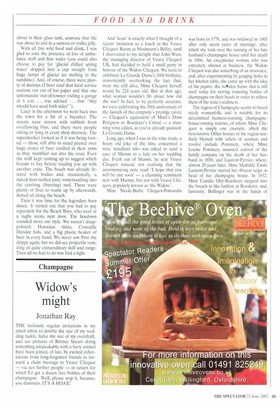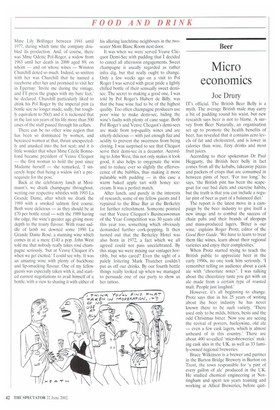Champagne
Widow's might
Jonathan Ray
THE tediously regular invitations in my email inbox to double the size of my wedding tackle, halve the size of my overdraft, and see pictures of Britney Spears doing something unspeakable with a furry animal have been joined, of late, by excited exhortations from long-forgotten friends to forward a chain message to Veuve Clicquot — via ten further people — in return for which I'd get a dozen free bottles of their champagne. Well, please stop it, because, you dummies, IT'S A HOAX!
And 'hoax' is exactly what I thought of a recent invitation to a lunch in the Veuve Clicquot Room at Mosimann's Belfry, until I discovered to my delight that John West, the managing director of Veuve Clicquot UK, had decided to hold a small party in honour of the Widow Clicquot. We were to celebrate La Grande Dame's 30th birthday, conveniently overlooking the fact that, were she still alive, Mme Clicquot herself would be 224 years old. But at that age, what woman wouldn't fib about how old she was? In fact, to be perfectly accurate, we were celebrating the 30th anniversary of the launch of the company's prestige cuvee — Clicquot's equivalent of Moat's Dom Perignon or Roederer's Cristal — a stunning wine called, as you've already guessed, La Grande Dame.
Long ago, when I was in the wine trade, a hoary old joke of the time concerned a wine merchant who was asked to send a case of Murnm to a lady on her wedding day. Fresh out of Mumm, he sent Veuve Clicquot instead, not realising that the accompanying note read: 'I hope that you will be one soon' — a charming sentiment sent with Mumm, but not with Veuve Clicquot, popularly known as 'the Widow'.
Mme Nicole-Barbe Clicquot-Ponsardin was born in 1778, and was widowed in 1805 after only seven years of marriage, after which she took over the running of her late husband's champagne house until her death in 1866. An exceptional woman who was extremely shrewd at business, the Widow Clicquot was also something of an innovator, and, after experimenting by gauging holes in her kitchen table, she came up with the idea of the pupirre, the wotden frame that is still used today for storing maturing bottles of champagne on their heads in order to relieve them of the wine's sediment.
The region of Champagne seems to breed steely womenfolk, and is notable for its determined business-running, champagnehouse-owning widows, of whom Mme Clicquot is simply one example, albeit the best-known. Other houses in the region similarly blessed with relicts of acumen and resolve include Pommery, where Mme Louise Pommery assumed control of the family company on the death of her husband in 1858, and Laurent-Perrier, where, almost 20 years later, Mme Mathilde Emile Laurent-Perrier started her 40-year reign as head of her champagne house. In 1932, Mme Camille Olry-Roederer stepped into the breach in like fashion at Roederer, and, famously, Bollinger was in the hands of Mme Lily Bollinger between 1941 until 1977, during which time the company doubled its production. And, of course, there was Mme Odette Pol-Roger, a widow from 1963 until her death in 2000 aged 89, on whom — and on whose wines — Winston Churchill doted so much. Indeed, so smitten with her was Churchill that he named a racehorse after her and promised to visit her in Epernay: 'Invite me during the vintage, and press the grapes with my bare feet,' he declared. Churchill particularly liked to drink his Pot Roger by the imperial pint (a bottle size no longer made, sadly, but roughly equivalent to 50c1) and it is reckoned that in the last ten years of his life more than 500 cases of the stuff passed through his cellars.
There can be no other wine region that has been so dominated by women, and bereaved women at that, thrust unexpectedly and unasked into the hot seat; and it is little wonder that when Mme Cecile Bonnefond became president of Veuve Clicquot — the first woman to hold the post since Madame herself — she remarked, 'I sincerely hope that being a widow isn't a prerequisite for the post.'
Back at the celebratory lunch at Mosimann's, we drank champagne throughout, wetting our respective whistles with 1993 La Grande Dame, after which we drank the 1989 with a smoked salmon first course. Both were delicious — as they should be at £70 per bottle retail — with the 1989 having the edge, the wine's greater age giving more depth to the toasty flavour. With roast saddle of lamb we downed some 1990 La Grande Dame Rosé, a stunning wine which comes in at a mere £140 a pop. John West told me that nobody really takes rosé champagne seriously, 'but at Veuve Clicquot it's when we get excited.' I could see why. It was an amazing wine with plenty of backbone and lip-smacking flavour. One of my fellow guests was especially taken with it, and started earnest negotiations to avail himself of a bottle, with a view to sharing it with either of his alluring lunchtime neighbours in the twoseater Mont Blanc Room next door.
It was when we were served Veuve Clicquot Demi-Sec with pudding that I decided to cancel all afternoon engagements. Sweet champagne is usually regarded as rather infra dig, but that really ought to change. Only a few weeks ago on a visit to Pot Roger I was served with great pride a lightly chilled bottle of their sensually sweet demisec. The secret to making a good one, I was told by Pot Roger's Hubert de Billy, was that the base wine had to be of the highest quality. Too often champagne producers use poor wine to make demi-sec, hiding the wine's faults with plenty of cane sugar. Both Pot Roger's and Veuve Clicquot's demi-secs are made from top-quality wines and are utterly delicious — with just enough fizz and acidity to prevent the sweetness from being cloying. I was surprised to see that Clicquot serve their demi-sec in a decanter. According to John West, this not only makes it look good, it also helps to oxygenate the wine and to reduce ever so slightly the effervescence of the bubbles, thus making it more palatable with pudding — in this case a warm baked apple tart with honey icecream. It was a perfect match.
After lunch, and purely in the interests of research, some of my fellow guests and I repaired to the Blue Bar at the Berkeley for further refreshment. Someone pointed out that Veuve Clicquot's Businesswoman of the Year Competition was 30 years old this year too, something which obviously demanded further cork-popping. It then turned out that the Berkeley Hotel was also born in 1972, a fact which we all agreed could not pass uncelebrated. By this stage we were mixing our vintages horribly, but who cared? Even the sight of a palely loitering Mark Thatcher couldn't put us off our drinks. By our fourth bottle things really looked up when we managed to persuade one of our party to show us her tattoo.











































































 Previous page
Previous page